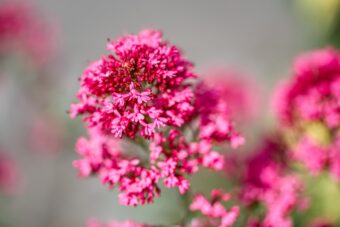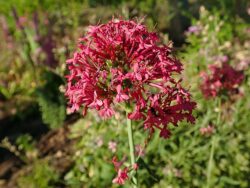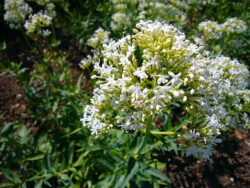In this article, we will discuss how to grow the wonderful perennial wildflower called Centranthus in containers. Centranthus is a flowering perennial or sub-shrub that is native to South Europe. It is a member of the Caprifoliaceae family, the honeysuckle family. It does not look like honeysuckle but it is part of the family.

Twelve species are known to exist, where Centranthus ruber is the most known. If you look at the British countryside, you will find the plant growing on old walls and gravel paths.
The flowers are small and are borne in large clusters above the lance-shaped, green leaves. The blooms are often red, but white or pink varieties exist and they are slightly fragrant.
As they will grow anywhere, they are an undemanding plant, provided it is grown in full sun. You may not naturally think that this plant will look good in containers but they do if you want a tough plant to grow in one, then this is for you.
Centranthus has one main disadvantage and that it is a short-lived plant but it makes it up by self-seeding everywhere. A plant that will attract butterflies and bees, so great as part of a wildlife container display.
Find out how to grow this perennial in containers in this article.
GROWING CENTRANTHUS IN CONTAINERS
You have a choice when growing Centranthus as they can be easily grown from seeds or if you do not have the time, you can buy and grow from garden-ready plants.
CENTRANTHUS FROM SEED
You can start the seed in March by filling a seed tray with a moist, good quality seed sowing compost, On top of this sprinkle the seed thinly and just cover it with a thin layer of seed sowing compost. Place a propagator lid on and place it in a warm room. After 21 to 30 days the seed should have germinated.
Allow the plant to grow on and when they are large enough to handle, you can prick them out and transplant them into 7.5cm pots full of multipurpose compost. Allow the plants to grow on and in mid-May, you can start hardening off before planting outside in late May.
At this stage, shop-bought and home-reared plants can be treated in exactly the same way.

First, choose a container that is well proportioned with the plant in question. No matter what you use make sure it has plenty of drainage holes in it. I would recommend using one plant per container.
On top of the bottom of the container add a 1cm layer of gravel to aid drainage even more and on top of this add multipurpose compost until it reaches 5cm below the rim. Dig a hole in the centre of the container slightly larger than the root ball it came in the original container. Drop the plant in so that top of the root ball is at the same level as the top surface of the compost. Backfill with the growing media so that no gaps remain, using more compost if you have to. Firm the plant in and water it well. You can cover the surface of the pot with some large stones to give a natural wildlife look.
CARE INSTRUCTIONS
If you want the plant to look at its best, you will have to grow it in full sun. This is one plant that does not like hot, dry summer, so do not expect the plant to do well under these conditions.

Once established it will take drought pretty well but until then water frequently especially when 5cm below the top surface of the container feels dry to the touch.
As it grows often in poor conditions, it will not need fertilizing at all, unless the plant is clearly showing a deficiency.
You will need to remove spent blooms to encourage further blooming and this will also prevent seeds from growing into future plants.
PESTS AND DISEASES
In general, pests seem to avoid them but they can suffer from aphids or whiteflies. This can be dealt with by blasting them with jets of water or if it is really bad, you can use a suitable systemic insecticide.
They do not suffer from diseases, which is an added bonus.
VARIETIES TO GROW

The species you are likely to find are based on the Centranthus ruber described in the introduction. The main variety produces pink but they are white varieties of ‘Albus’ and ‘Snowcloud’, where bright crimson flowers are produced on ‘Coccineus’
CONCLUSIONS
In this article, we have discussed how to grow the beautiful but short-lived perennial of Centranthus in containers. They are such magnets to butterflies and bees and are easy to grow and care for. A plant that can be grown in containers and should be grown in containers if you want a tough plant.
If you have any questions or comments that you wish to make on growing Centranthus in containers, please do so in the comment box below.
Happy Centranthus growing.
